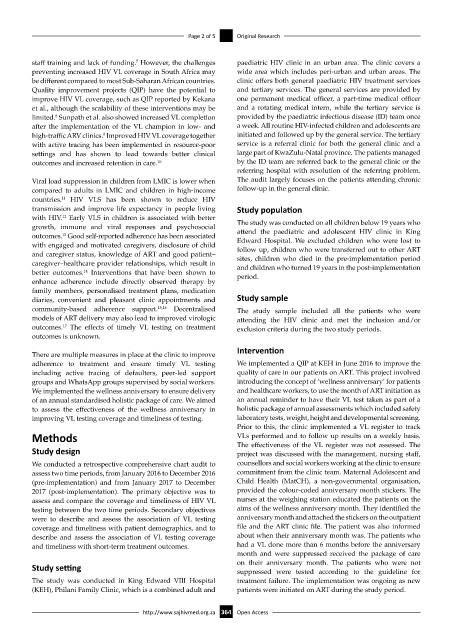Page 372 - HIVMED_v21_i1.indb
P. 372
Page 2 of 5 Original Research
7
staff training and lack of funding. However, the challenges paediatric HIV clinic in an urban area. The clinic covers a
preventing increased HIV VL coverage in South Africa may wide area which includes peri-urban and urban areas. The
be different compared to most Sub-Saharan African countries. clinic offers both general paediatric HIV treatment services
Quality improvement projects (QIP) have the potential to and tertiary services. The general services are provided by
improve HIV VL coverage, such as QIP reported by Kekana one permanent medical officer, a part-time medical officer
et al., although the scalability of these interventions may be and a rotating medical intern, while the tertiary service is
8
limited. Sunpath et al. also showed increased VL completion provided by the paediatric infectious disease (ID) team once
after the implementation of the VL champion in low- and a week. All routine HIV-infected children and adolescents are
9
high-traffic ARV clinics. Improved HIV VL coverage together initiated and followed up by the general service. The tertiary
with active tracing has been implemented in resource-poor service is a referral clinic for both the general clinic and a
settings and has shown to lead towards better clinical large part of KwaZulu-Natal province. The patients managed
outcomes and increased retention in care. 10 by the ID team are referred back to the general clinic or the
referring hospital with resolution of the referring problem.
Viral load suppression in children from LMIC is lower when The audit largely focuses on the patients attending chronic
compared to adults in LMIC and children in high-income follow-up in the general clinic.
countries. HIV VLS has been shown to reduce HIV
11
transmission and improve life expectancy in people living Study population
12
with HIV. Early VLS in children is associated with better The study was conducted on all children below 19 years who
growth, immune and viral responses and psychosocial
outcomes. Good self-reported adherence has been associated attend the paediatric and adolescent HIV clinic in King
13
with engaged and motivated caregivers, disclosure of child Edward Hospital. We excluded children who were lost to
follow up, children who were transferred out to other ART
and caregiver status, knowledge of ART and good patient– sites, children who died in the pre-implementation period
caregiver–healthcare provider relationships, which result in and children who turned 19 years in the post-implementation
better outcomes. Interventions that have been shown to period.
14
enhance adherence include directly observed therapy by
family members, personalised treatment plans, medication
diaries, convenient and pleasant clinic appointments and Study sample
community-based adherence support. 15,16 Decentralised The study sample included all the patients who were
models of ART delivery may also lead to improved virologic attending the HIV clinic and met the inclusion and/or
outcomes. The effects of timely VL testing on treatment exclusion criteria during the two study periods.
17
outcomes is unknown.
Intervention
There are multiple measures in place at the clinic to improve
adherence to treatment and ensure timely VL testing We implemented a QIP at KEH in June 2016 to improve the
including active tracing of defaulters, peer-led support quality of care in our patients on ART. This project involved
groups and WhatsApp groups supervised by social workers. introducing the concept of ‘wellness anniversary’ for patients
We implemented the wellness anniversary to ensure delivery and healthcare workers, to use the month of ART initiation as
of an annual standardised holistic package of care. We aimed an annual reminder to have their VL test taken as part of a
to assess the effectiveness of the wellness anniversary in holistic package of annual assessments which included safety
improving VL testing coverage and timeliness of testing. laboratory tests, weight, height and developmental screening.
Prior to this, the clinic implemented a VL register to track
Methods VLs performed and to follow up results on a weekly basis.
Study design The effectiveness of the VL register was not assessed. The
project was discussed with the management, nursing staff,
We conducted a retrospective comprehensive chart audit to counsellors and social workers working at the clinic to ensure
assess two time periods, from January 2016 to December 2016 commitment from the clinic team. Maternal Adolescent and
(pre-implementation) and from January 2017 to December Child Health (MatCH), a non-governmental organisation,
2017 (post-implementation). The primary objective was to provided the colour-coded anniversary month stickers. The
assess and compare the coverage and timeliness of HIV VL nurses at the weighing station educated the patients on the
testing between the two time periods. Secondary objectives aims of the wellness anniversary month. They identified the
were to describe and assess the association of VL testing anniversary month and attached the stickers on the outpatient
coverage and timeliness with patient demographics, and to file and the ART clinic file. The patient was also informed
describe and assess the association of VL testing coverage about when their anniversary month was. The patients who
and timeliness with short-term treatment outcomes. had a VL done more than 6 months before the anniversary
month and were suppressed received the package of care
on their anniversary month. The patients who were not
Study setting suppressed were tested according to the guideline for
The study was conducted in King Edward VIII Hospital treatment failure. The implementation was ongoing as new
(KEH), Philani Family Clinic, which is a combined adult and patients were initiated on ART during the study period.
http://www.sajhivmed.org.za 364 Open Access

